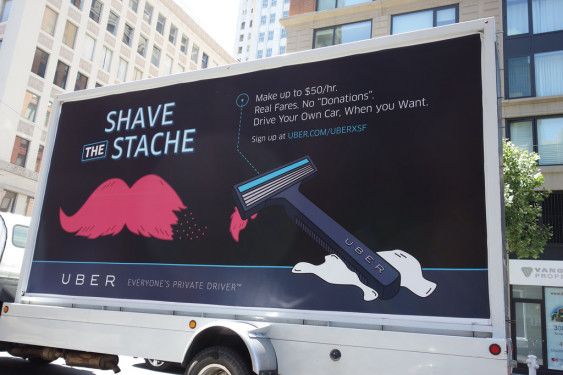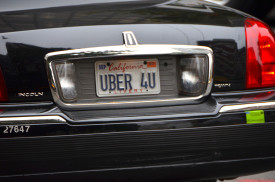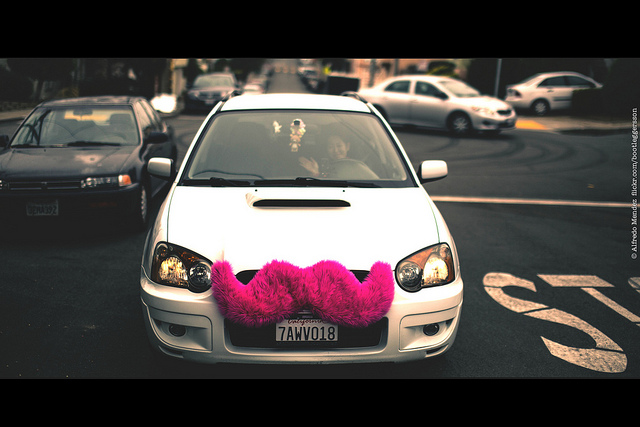The debate over crafting new rules for Seattle’s evolving for-hire industry has lasered in on a interesting question: What will on-demand ridesharing apps like Lyft, Sidecar and uberX look like when they reach a critical mass?
Will they popularize paid ridesharing by connecting people with empty seats in their car with people who need rides? Imagine if someone who happened to be driving from Shoreline to IKEA could open an app and connect with car-free shoppers who need a ride there. Or if someone headed to a meeting in Olympia with an empty car could pick up others headed that way. This could unlock tons of wasted space in our personal cars and create a online marketplace to encourage carpooling on the fly.
Or will these paid ridesharing services simply turn into taxi services with less overhead and fewer regulations? In this scenario, the drivers aren’t really “sharing” rides at all. The drivers are still making it easier for their passengers to live a car-lite or car-free lifestyle, but they’re primarily earning an income by circling around in their personal cars and driving people where they need to go.
This question arose because right now, a Seattle City Council committee is leaning towards regulating on-demand ridesharing services, which are arguably violating city laws right now, with a lighter hand than today’s professional for-hire and taxi services. This could turn out to be fundamentally unfair to current drivers (many of whom are immigrants and people of color) if they have to follow more stringent rules to provide essentially the same service.
Here’s how Sally Clark, chair of the Seattle City Council’s Committee on Taxi, For-Hire, and Limousine Regulations framed the debate:
What ridesharing is supposed to be is part-time drivers who aren’t out there all the time. And if that’s really the model I have less concern…. The idea is that this would be creating a space to help serve a market that people are excited about. If we’re simply creating a cut-rate way to be a taxi then I don’t think that’s the direction we wanted to go.
The fact is that most “ridesharing” companies today are operating a lot like taxis (but with better service). In Lyft’s current app, drivers don’t even know a customer’s destination until he or she hops in the front seat, which means there’s no real sharing happening at all. Lyft argues that this is just a baby step on the road to true ridesharing nirvana, where someone headed to a Microsoft conference or Mariners game could hitch a paid ride with someone already taking that trip. To get there, the company argues, a critical mass of rideshare drivers need to be on the road, and barriers to join that pool must be low.

That’s why, in part, a majority on the Seattle city council taxi committee is leaning towards a scenario (Option 3 on this chart) that would make smartphone-based ridesharing companies legal but create a different set of regulations for them to follow. There are still significant details to be worked out, and here are some of the main points of contention:
Rideshare rules and driver licenses
The working proposal would subject parent companies like Uber or Sidecar to basic health and safety regulations, which could look much like new ridesharing rules recently approved in California. Those cover everything from vehicle inspections to insurance minimums to driver training. In Seattle, a rideshare driver would also have to get a special for-hire vehicle driver license, which is available to anyone after two days of training and passing oral, written, and medical exams.
Some ridesharing companies feel a special driver license will discourage participants and kill the ridesharing revolution before it even gets started. Committee members seemed open to a streamlined training process for rideshare drivers. But council member Mike O’Brien made clear that he didn’t want to subject taxi drivers to special training and give rideshare drivers an entirely free pass:
Requiring [rideshare] drivers to have a specific driver’s license is important to me. Whether that’s the one we have today or something different, that may evolve over time. But I’m not prepared to say that a certain type of driver in our community can do nothing and another type of driver has to spend two days in a class with maps.
Vehicle caps
One of the major unresolved questions is how much the city will loosen current caps on taxi and for-hire vehicle licenses and whether it might potentially limit the number of ridesharing vehicles. Unlike a for-hire driver license, which an unlimited number of people can get, the city currently limits the number of vehicle licenses it gives out, which limits the number of legal taxis and for-hire vehicles that can be on the road.
The initial proposal would only slightly expand the number of Seattle taxi licenses by 50 (from 688), and allow some of the 195 for-hire vehicle license holders to convert to taxi licenses. This would allow them to pick up street hails and give them a slight competitive edge over rideshare and limo drivers, who are only supposed to accept prearranged fares. The majority of committee members seemed disinclined to cap ridesharing vehicles, although Council Member Bruce Harrell pushed strongly for that idea:
I don’t like the wide open notion of how we’re treating rideshares. I think we have to restrict it more. I don’t see how we don’t contain the number of rideshare drivers when we do it so heavily in the taxis and for-hires…. I’d rather try to put the genie back in the bottle as we come up with this new regulatory scheme, but I’m probably in the minority opinion on this.
Special treatment
The proposed ideas would bring ridesharing vehicles and drivers closer in line with regulations that current professional for-hire drivers must follow. But to varying degrees (depending on final details), the ridesharing rules would still be less stringent.
Why? The presumption seems to be that on-demand ridesharing drivers are somewhat different and less professional. That they’re doing it part-time between music or substitute teaching gigs, and shouldn’t be as inconvenienced as someone for whom driving is a main source of income. But we really have no idea how many hours a week rideshare drivers are working or how many vehicles are out there. The ridesharing companies, which seem remarkably professional when you look at their technological and marketing innovations, have declined to share that information.
Clark, the taxi committee chair, floated the idea of limiting the number of hours that a rideshare driver could drive or the number of vehicles that Lyft or Sidecar could have on the roads at one time in order to qualify for the less stringent regulation. But why the two-tiered regulatory structure would exist in the first place is a bit of a mystery.

Why would the city need to protect the public more, or differently, from professional taxi drivers than from people casually running around with pink mustaches on their personal cars? It seems like they both ought to be regulated to give customers basic protections, and in much the same way. Because maybe smartphone-based ridesharing isn’t going to turn out to be about community-building and carpooling and transformative transportation. Maybe they’re just offering a smart, beneficial service that people like—one that still makes it easier for greater numbers of people to get by without personal vehicles—and they shouldn’t be penalized for being too professional or successful.
So if one agrees that the playing field ought to be pretty level between current taxi drivers and the new ridesharing services, the city has two choices. They can try to regulate new ridesharing entries with caps and regulations that have produced a monopoly that’s been painfully slow to innovate and respond to customer service shortcomings. Or they can try to move the current taxi and for-hire industry towards a less constrained model that people (based on the growing number of rideshare and limo customers) seem to be happy with.
The council’s working plan moves in the latter direction, but it could go further. It may be true that with more drivers-for-hire on the road, competition will increase and some drivers may have an even harder time making a living. But continuing to regulate taxi service with rules put in place when Apple released the Macintosh II and Donkey Kong Jr. was a popular video game doesn’t seem likely to help drivers compete in the long run.
Phasing out taxi caps, streamlining regulations with basic health and safety in mind, and allowing taxi and for-hire drivers to compete equally in a marketplace that’s been flooded with unlimited numbers of limos and pink mustaches makes more sense in a 21st century world.


Comments are closed.